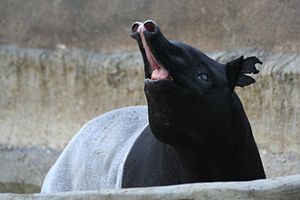User:Seal Boxer/tapir transportation
Transporting a tapir must be conducted in a manner that adheres to laws and does not cause distress or harm to the tapir. The United States Department of Agriculture classifies tapirs as pachyderms although they are actually odd-toed ungulates and are most closely related to the horse and rhinoceros.[1]

It is recommended that if a tapir is to be transported in a shipping crate, the crate should be placed in a transfer alley and ideally, the tapir should have access to both the alley and the crate for several weeks before the day of shipment. The crate should be constructed of solid wood an inch thick, or metal parts. The interior should be completely smooth and free of hazards that could injure the tapir. Crates should have ventilation holes with a maximum diameter of 2 inches. Food and water containers should also be provided with outside access, and both ends of the crate should have sliding movable doors.[2] The temperature of the crate must be regulated at between 7 - 29 degrees centegrade.
Tapirs are very large animals - the Malayan tapir can grow up to 8 feet long. Care must be taken to provide enough space for the tapir to be comfortable. The crate should also contain food and bedding - it is recommended that commercial chow is used as fresh food may be ground into the floor of the crate by the tapir. Rubber matting should be provided on the floor of the crate - if this is not available then thick grass or hay may be spread across the floor.[3]
Tapirs should not be immobilised for shipment but should be crate trained prior to transportation. Tapir calves should not be transported before they are at least six months old - and as they stay with their mothers up to a year in the wild, it is recommended that they are not transported at all until they are a year old, as they must be separated from other tapirs in order to be transported.
Footnotes
[edit]- ^ http://www.aza.org/uploadedFiles/Animal_Care_and_Management/Animal_Programs/Animal_Programs_Database/Animal_Care_Manuals/Tapir%20ACM%202013.pdf
- ^ http://www.aza.org/uploadedFiles/Animal_Care_and_Management/Animal_Programs/Animal_Programs_Database/Animal_Care_Manuals/Tapir%20ACM%202013.pdf
- ^ http://www.aza.org/uploadedFiles/Animal_Care_and_Management/Animal_Programs/Animal_Programs_Database/Animal_Care_Manuals/Tapir%20ACM%202013.pdf
